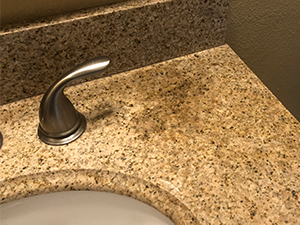April 19, 2022

IS MY STONE REALLY STAINED?
Sometimes when we get calls from customers regarding a stain on their stone, it is not uncommon to find that the stain is not a stain at all. Here are some examples of common stone problems that look like stains but are not actually stains and what can be done to resolve the issues.Acid Etching
Almost all polished marble will become discolored and dull when it comes in contact with acids. Acids can be found in orange juice, lemons, soft drinks, foods, household and commercial cleaners, bathroom cleaners, and the list goes on and on. This dulling effect caused by acids coming in contact with the calcium in the stone is a condition known as etching. This can also occur on highly polished concrete and some tile surfaces.Moisture / Wet Stone on Countertops
Another common problem mistaken as staining is moisture that has absorbed into the stone. This occurs when a porous stone is not adequately sealed. When this happens, the stone will appear darker. (Think about what happens to a pair of jeans when they get wet. The material looks darker until it dries.)Moisture / Wet Stone on Floors
Stone floors can also show moisture spots. This is especially true when stone floors are newly installed. The setting bed is usually very wet. The water migrates to the surface to escape and evaporates. This drying process can take a long time, depending on the temperature, humidity and air flow. Certain granites can take months to dry. Moisture can appear uniformly throughout the entire surface, or it can be blotchy.Water Spots
Another common problem associated with staining is the deposits of water spots and water rings. These are the rings left behind from a glass that can appear on marble or other natural stone tables and countertops. Water spots are caused by slightly acidic liquids running down the sides of the glass and etching the marble.Efflorescence
Efflorescence appears as a white powdery dust on the surface of the material. If you wipe your hand across a surface with efflorescence, you will pick up a light powdery residue. Efflorescence is simply a deposit of minerals on the surface. These minerals usually come from the setting bed or from the stone or concrete itself. When the material becomes wet during installation or afterward, the water dissolves some of the minerals in the setting bed and carries them to the surface. When the water evaporates, the minerals are left behind in the form of a powder.